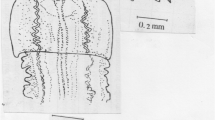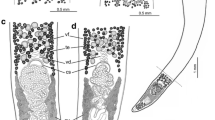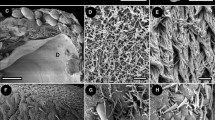Abstract
Adult cestodes recovered from the small intestines of water rats (Hydromys chrysogaster) in Northern Tasmania were identified, on the basis of their morphology and the developmental requirements of their coracidia, as non-marine members of the genus Diphyllobothrium. The exact taxonomic position of this diphyllobothriid is not known. It differs in some respects from Stephens' (1908) description of a parasite (Diphyllobothrium parvum) obtained from the same locality, but could not be clearly differentiated from D. dendriticum. Thus, until more information is available about the full life cycle of this parasite, we consider it to be D. dendriticum. ac]19860728
Similar content being viewed by others
References
Andersen, K. (1971) Studies on the helminth fauna of Norway. XVII. Morphological comparison of Diphyllobothrium dendriticum Nitzsch, 1824, D. norvegicum Vik, 1957 and D. latum (Linne, 1758) (Cestoda: Pseudophyllidea). Norwegian Journal of Zoology, 19, 21–36.
Andersen, K. (1972) Studies on the helminth fauna of Norway. XXIV: The morphology of Diphyllobothrium ditremum (Creplin, 1825) from the golden hamster (Mesocricetus auratus [Waterhouse, 1839]) and a comparison with D. dendriticum (Nitzsch, 1824) and D. latum (L., 1758) from the same host. Norwegian Journal of Zoology, 20, 255–264.
Andersen, K. (1975) Studies on the helminth fauna of Norway. XXXIV: The morphological stability of Diphyllobothrium Cobbold. A comparison of adult D. dendriticum (Nitzsch), D. latum (L.) and D. ditremum (Creplin) developed in different hosts. Norwegian Journal of Zoology, 23, 45–53.
Andersen, K. & Halvorsen, O. (1978) Egg size and form as taxonomic criteria in Diphyllobothrium (Cestoda; Pseudophyllidea). Parasitology, 76, 229–240.
Bylund, G. (1969) Experimentell undersökning av Diphyllobothrium dendriticum (= D. norvegicum) fran norra Finland. Tiedoksianto Information, 10, 3–17.
Bylund, G. (1973) Observations on the taxonomic status and the biology of Diphyllobothrium ditremum (Creplin, 1825) (= D. osmeri (Von Linstow, 1878). Acta Academiac Åboensis, Series B, 33(19), 1–18.
Bylund, G. (1975) The taxonomic significance of embryonic hooks in four European Diphyllobothrium species (Cestoda, Diphyllobothriidae). Acta Zoologica Fennica, 142, 1–22.
Dick, T.A. & Poole, B.C. (1985) Identification of Diphyllobothrium dendriticum and Diphyllobothrium latum from some freshwater fishes of central Canada. Canadian Journal of Zoology, 63, 196–201.
Grabiec, S., Guttowa, A. & Michajlow, W. (1963) Effect of light stimulus on hatching of coracidia of Diphyllobothrium latum (L.) Acta Parasitologica Polonica, 11, 229–238.
Hilliard, D.K. (1960) Studies on the helminth fauna of Alaska. XXXVIII. The taxonomic significance of the eggs and coracidia of some diphyllobothriid cestodes. Journal of Parasitology, 46, 703–716.
Li, H.C. (1929) The life histories of Diphyllobothrium decipiens and D. erinacei. American Journal of Hygiene, 10, 527–555.
Mackerras, M.J. (1958) Catalogue of Australian mammals and their recorded internal parasites. Proceedings of the Linnean Society of New South Wales, 83, 101–160.
Morishita, K. (1972) Rare human tapeworms reported from Japan. Part IV. So-called Diphyllobothrium parvum (Stephens, 1908). In: Morishita, K., Komiya, Y. & Matsubayashi, H. (Eds) Progress of Medical Parasitology in Japan. Tokyo: Meguro Parasitological Museum, 4, 477–478 & 487.
Mueller, J.F. (1937) A repartition of the genus Diphyllobothrium. Journal of Parasitology, 23, 308–310.
Mueller, J.F. (1974) The biology of Spirometra. Journal of Parasitology, 60, 3–14.
Obendorf, D.L. & Smales, L.R. (1985) The internal parasites and pathological findings in Hydromys chrysogaster (Muridae: Hydromyinae) from Tasmania. Australian Journal of Zoology, 33, 33–38.
Olsen, P.D. (1983) The water-rat (Hydromys chrysogaster). In: Strahan, R. (Ed) The complete book of Australian mammals. Melbourne, London: Angus and Robertson, pp. 367–368.
Stephanson, J.M. (1985) Biology and immunobiology of Spirometra in Western Australia. Ph.D. Thesis, Murdoch University, Western Australia, 247 pp.
Stephens, J.W.W. (1908) Two new human cestodes and a new linguatulid. American Tropical Medicine Parasitology, 1, 549–556.
Stunkard, H.W. (1965) Variation and criteria for generic and specific determination of diphyllobothriid cestodes. Journal of Helminthology, 39, 281–296.
Vik, R. (1957) Studies on the helminth fauna of Norway. I. Taxonomy and ecology of Diphyllobothrium norvegicum n. sp. and the plerocercoid of Diphyllobothrium latum (L.). Nytt Magasin för Zoologi, 5, 28–93.
Vik, R. (1964) The genus Diphyllobothrium. An example of the interdependence of systematics and experimental biology. Experimental Parasitology, 15, 361–380.
Yazaki, S. (1982) Studies on three dimensional features of embryonic hooks in some species of diphyllobothriids, with special reference to taxonomic significance. Japanese Journal of Parasitology, 31, 435–446.
Author information
Authors and Affiliations
Rights and permissions
About this article
Cite this article
Stephanson, J.M., Obendorf, D.L. & Shaw, G. Diphyllobothrium dendriticum (Cestoda: Pseudophyllidea) from Tasmania. Syst Parasitol 9, 227–233 (1987). https://doi.org/10.1007/BF00010858
Accepted:
Issue Date:
DOI: https://doi.org/10.1007/BF00010858




